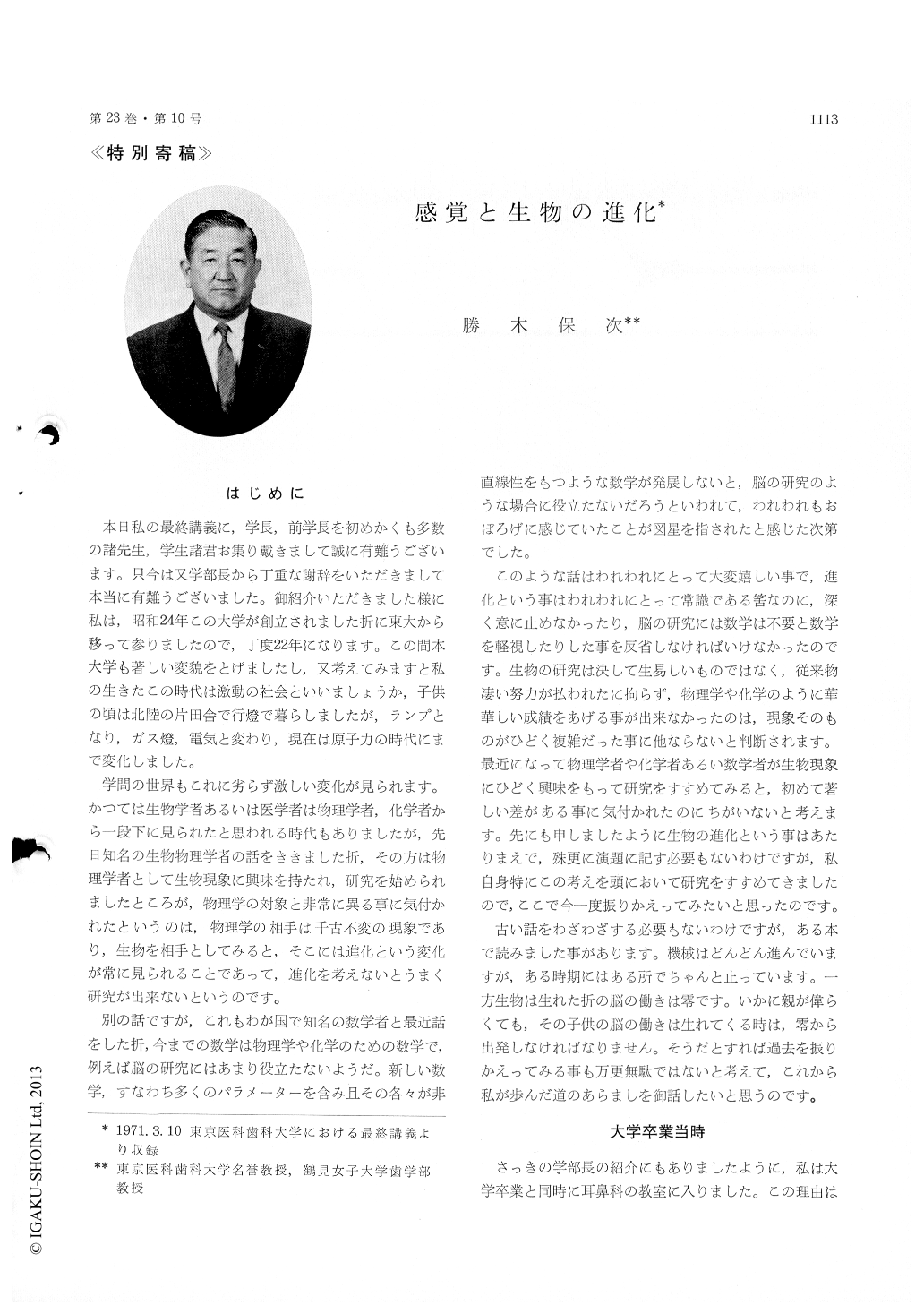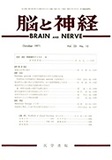Japanese
English
- 有料閲覧
- Abstract 文献概要
- 1ページ目 Look Inside
はじめに
本日私の最終講義に,学長,前学長を初めかくも多数の諸先生,学生諸君お集り戴きまして誠に有難うございます。只今は又学部長から丁重な謝辞をいただきまして本当に有難うございました。御紹介いただきました様に私は,昭和24年この大学が創立されました折に東大から移って参りましたので,丁度22年になります。この間本大学も著しい変貌をとげましたし,又考えてみますと私の生きたこの時代は激動の社会といいましょうか,子供の頃は北陸の片田舎で行燈で暮らしましたが,ランプとなり,ガス燈,電気と変わり,現在は原子力の時代にまで変化しました。
学問の世界もこれに劣らず激しい変化が見られます。かつては生物学者あるいは医学者は物理学者,化学者から一段下に見られたと思われる時代もありましたが,先日知名の生物物理学者の話をききました折,その方は物理学者として生物現象に興味を持たれ,研究を始められましたところが,物理学の対象と非常に異る事に気付かれたというのは,物理学の相手は千古不変の現象であり,生物を相手としてみると,そこには進化という変化が常に見られることであって,進化を考えないとうまく研究が出来ないというのです。
This is the final lecture delivered at Tokyo Medi-cal and Dental University, School of Medicine, where the author founded the 1st Department of Physiology in 1949. The author's main interest in physiology consisted in the sensory mechanism, es-pecially in the mechanism of hearing. Soon after his graduation from the medical school, Tokyo University, he entered the Department of Otolaryn-gology and became to feel interest in the auditory mechanism. At that time Georg von Bekesy reveal-ed the cochlear mechanism and the present author was much influenced by his way of thinking in experimental works and attempted to study the neural mechanism of hearing in animals from the phylogenetic point of view that Bekesy bore.
At first the author studied the lateral-line organs of fish morphologically and electrophysiologically in 1952. He succeeded in isolation of the single fiber from the lateral-line nerve and could obtain the unitary nerve responses to various kinds ofmechanical and electrical stimulations. Based on those experimental results he and his associates thereafter tried to record the unitary responses of the auditory nerve of cats to sound stimulations. The author introduced the glass-capillary micro-electrode methode to recording neural responses from several neuclei along the auditory tract in cats ; i. e. the auditory nerve, cochlear nuclei, trapezoid body, inferior colliculus, medial geniculate body and the auditory cortex, as well.
The response areas of the single neurons were found to be different at different levels. Up to the thalamus, the higher the level of neuron, the nar-rower the response area. This may mean that the frequency analysis of sound is accomplished while the informations about the sound frequency are going up along the auditory tract. In this point Rutherford's hypothesis is rather affirmable, compared with Helmholtz's "Resonance Theory".
The linear relationship between the impulse fre-quency of neuron and the intensity of stimulus sound was obtained at any level from the periphery up to the thalamus, although the rate of frequency increase was different at different levels.
Against the expectation most neurons encountered at the auditory cortex I, showed much broader response areas than those encountered at the geni-culate level and furthermore the discharge pattern of neuron was remarkably different from those observed at the lower levels. Discharges of neuronsthere were mostly phasic, on, off, or on-off discharges. At the lower levels discharges were continuous as long as the stimulating sound continued.
From the results described above the author finally concluded that in the cat or monkey the pitch and loudness of sound might be discriminated at the thalamus and the tone quality at the cortex.
The second part of the lecture was concerned with the chemoreception of the lateral-line organs of the aquatic animals. To date the lateral-line organ of fish has been known to be a mechanore-ceptor and thought as the origin of the inner ear of the higher animal. The author and his associates, however, discovered the chemoreception of that organ, especially of the freestanding neuromast, not only of elasmobranch and teleost, but also of amphibian. Potassium ions were found to be most effective. The concentration of potassium ions in the environment influenced the threshold of that organ as the mechanoreceptor. Due to such ex-perimental results it may be said that the lateral-line organs, except the canal organs, have the dual functions, mechanoreception and chemoreception and therefore they are better models of the inner ears of higher animals.
On the other hand this sort of chemoreception may be the primitive salt sensation in the animals.
The lateral-line organs of aquatic animals may be said to be the common origin of both the inner ear and the taste organ of the higher animal.

Copyright © 1971, Igaku-Shoin Ltd. All rights reserved.


